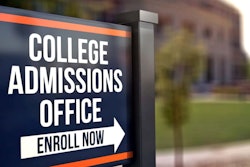Staying Power: Colleges Work to Improve Retention Rates
By Hilary Hurd
HAMPTON, Va.
T wo years ago, Wilbur Powell was a first-semester freshman. He slept too much, watched too much TV and was not excited about the classes he was taking. By the end of the semester, he had a 1.3 grade-point average. Rudea Downs also was a first-semester freshman. She crammed for exams, did not manage her time, enjoyed her newfound sense of freedom and also slept too much. By the end of the semester, she had a 1.5 GPA.
Both Hampton University students, who had always done well in high school, received the dreaded letter from the dean’s office notifying them that they were on academic probation. Downs and Powell would now be required to attend Friday seminars about academic success and regularly meet with a faculty adviser.
They, like other students in the same boat at the historically Black Virginia university, had one semester to raise their GPA to at least a 2.0, or else.
“Basically the message is, ‘Get grades up or leave,’ ” says Dr. Rodney Smith, Hampton’s vice president for planning and dean of the Graduate College, who was formerly vice president of administrative services. “We’re kind of taking the tough-love approach. If the students don’t come to the workshops or meet with the dean, administration takes that as a sign that the student is not interested in staying at Hampton.”
The tough-love approach worked for Downs and Powell. Downs raised her GPA the next semester to a 2.3, and Powell ended his freshman year with a 3.6.
“I was only aiming for a 3.0,” says Powell, 20, now in his junior year. He admits to being a little scared about going to college in the first place. He says he didn’t know what to expect. Time management was one problem.
“Once I wrote down my schedule, I realized I had a lot of time,” Powell says. His faculty mentor had him set goals and reviewed his schedule with him weekly.
Powell, who’s from Bronx, N.Y., and a first-generation college student, now conducts the time management seminars with students who are where he was about two years ago.
“I tell the students to take things one day at a time,” he says.
Changing his major from music to math, Powell is a resident assistant in his dormitory and also tutors college-bound students in the Hampton City Public Schools.
“Everything is perfect,” Powell says.
Lifeblood of Institutions
But everything is not perfect — especially not the retention rates at historically Black colleges and universities.
Many institutions, including non-HBCUs, admit that until fairly recently retention has not been their main focus because they have been more concerned with getting students into their respective schools than with keeping them there. Yet, how to retain and graduate students is one of the major issues all higher education institutions are wrestling with.
“Retention is the lifeblood of an institution,” says Dr. Johnetta Cross Brazzell, who spent five years at Spelman College as vice president of student affairs before moving on last year to the same position at the University of Arkansas-Fayetteville. “It says a lot about the quality of the experience for the student. It’s something a university has to be responsive to.”
So why do some HBCUs have such low retention rates? Are there problems unique to HBCUs and to Black students in general that make it difficult for them to return year after year?
The answer is yes, and those problems run the gamut from finances to family support.
Dr. Jorge Fuentes, a retention expert and chairman of the Search for Education Elevation and Knowledge program at Hunter College in New York, says the most common reasons that students leave school are lack of financial assistance and being academically unprepared. Fuentes says some students don’t really know what they’re working toward when they get to college, so they flounder, become frustrated and leave.
“HBCUs really take students under their wing in most cases,” says Fuentes, who received his doctorate from historically Black Grambling State University in Louisiana. “But it’s the social and academic adjustment that determines whether a student makes it or not.”
There are some common characteristics among Black students and majority Black institutions that could play a factor in retention rates. HBCU administrators say many Black students are first-generation college students, meaning they are the first in their immediate families to attend college. So the family support of “been there, done that” is not present in many cases.
And with today’s soaring tuition rates, many administrators say they are seeing more students than ever before holding down a job — and not just part-time work, but a full-time position on top of taking a full load of classes.
“The mission of HBCUs is to provide an opportunity for higher education,” says Hampton’s Smith. “Therefore, HBCUs attract and accept students from a variety of socioeconomic backgrounds as well as various academic levels. So designing programs to address all of these issues is difficult,” he says, adding that most HBCUs do not have adequate resources to develop elaborate retention plans.
Smith says there are two categories of at-risk students: the “drop-outs” and the “stop-outs.”
The dropout rate is higher in the freshman year for various reasons, Smith says.
“In the transition from high school to college, many students find out that a particular college is not for them, or they may find out that they don’t want to go college, period, and would rather work,” Smith says. “But the [Faculty Development Advisor] program increases the probability of the student staying.”
The stop-out rate is higher in the classes beyond the freshman year, according to Smith. These students often “stop out” when they meet financial difficulties. The student will leave and work for a year, then come back. Smith says family financial problems often lead to this behavior.
“For many African American students, there are many other factors — societal pressures outside of school competing for their attention. Therefore, what’s going on inside HBCUs needs to be stronger than what’s going on outside. But until HBCUs are viewed and supported on par with other [non-HBCU] institutions, we will continue to see these low retention rates. This is really the message here.”
The majority of colleges and universities have tutoring programs and writing centers to assist students in a variety of subjects. The ideal situation, say many administrators, is to have a well-supported program to track every student and get them one-on-one help if they need it. But in most cases, the onus is on students to make their academic problems known.
INtrusive intervention
In 1994, officials at Hampton University — where 52 percent of students graduate within six years — decided they were going to track their freshman students and implement two programs in an effort to increase their retention rate. One program, the Faculty Development Advisors Program, pairs freshmen on academic probation with a faculty adviser who also serves as a mentor.
In the Early Detection Program, the university scans the midterm grades of all freshmen. Students with more than two Cs — or lower — are called in as a group. The students attend academic success workshops on Fridays. And any student who ignores the workshop notices speaks directly with the dean of students.
“Then what we have is a significant increase in students who have raised their GPAs and an overall increase in the freshman retention rate, which is now about 85 percent,” Smith says.
Kathy Block, assistant professor of nursing at Hampton as well as a 1987 graduate of the school, served as Rudea Down’s faculty adviser.
“I try to get them to tell me what they think is the problem and describe to me how they prepare for class,” Block says. “I remind them that it’s OK to have a social life, but that they are no longer in high school.”
Downs, 20, now a sophomore, says meeting with Block for advice helped raise her grades. She also learned how to manage her time, take notes and improve her study skills.
“I knew it was time to straighten up my act or I wouldn’t be returning the following year,” Downs says.
Connecting with Tradition
Though not an HBCU, the University of Arkansas-Fayetteville is working hard to ensure that freshmen return the following year. The university has seen increased retention rates among African American students on its campus, up from 80.7 percent in 1999 to 86 percent this year. In 1998, the African American freshman retention rate was 73.2 percent.
Arkansas’ Brazzell credits the university’s chancellor, Dr. John A. White, with putting the issue of retention on everybody’s radar screen as one of the most important issues facing the state and the university.
“How do we introduce them [students] and engage them in this campus, so they don’t even dream of leaving? That’s what we’ve been focusing on,” Brazzell says.
Last year the university introduced a new program called Connections, in which first-year students come one week before classes start and attend both a series of academic and social activities — all in the university’s effort to prep them for what life will be like at the University of Arkansas. The university also opened two residence halls that house mostly freshmen.
Brazzell also cites the benefits of history and traditions.
“What I learned at Spelman is that rituals and traditions mean something. Things that make people feel bonded to an institution causes the leaving rate to diminish considerably,” Brazzell says. For example, at Arkansas, a university tradition is the “Senior Walk” — everyone who graduates from the university gets his or her name engraved on the walk. And this year, the students in the freshman dorm attended a matriculation ceremony where they pledged to graduate.
Asking for Help
Sterling Hudson, dean of admissions and records at Morehouse College in Atlanta, says this all-male historically Black institution has a unique problem: the reluctance on the part of African American males to ask for help.
“They see themselves falling behind academically, and they think they can help themselves,” Hudson says. “By the time they ask for help, it’s too late. We don’t have enough of the human resource element to reach out to every individual student, so the responsibility is largely on students to make their problem known — and herein lies the problem.”
Hudson says that much of the focus on retention at Morehouse — where some 48 percent of students graduate in six years — begins before the student gets to campus.
“We make a strong effort to communicate with students well in advance that success at Morehouse depends on the effort that they put forth,” Hudson says. “If they come here with the right state of mind and work hard, we’re halfway there.”
Morehouse invites prospective students for five-day campus visits, where they attend seminars on academic success and related topics. The open house usually attracts between 250 and 300 students. In addition, the college’s six-week summer program, the Bridge program, gives students a glimpse of life at Morehouse.
Hudson says that financial problems and failing to maintain a balance between academics and a social life are just a few factors that can lead to problems with retention. But the college is taking a closer look at its attrition rates.
“We want to look in greater detail about why a student leaves Morehouse,” Hudson says. “We’re going to look at each reason — financial, academic record prior to coming to Morehouse, etc. We’re not satisfied that we’re doing the best we can. We first need to understand the problem better, and then we can come up with better answers.”
The ‘Other’ Factors
Talk to students and graduates of HBCUs and you will often hear about the enviable campus social life, the great peers, the nurturing and supportive professors and environment, the strong history of the institution — in a nutshell, most HBCU graduates wouldn’t trade their college experience for the world.
However, the same students also will tell stories of institutional disorganization, problems with financial aid, staff “with attitudes” and the red tape one must navigate to get things done. This side of the Black college experience also has an impact on the institutions in terms of retention and graduation rates.
“We forget that students are our business,” says Danielle Kennedy-Lamar, director of admissions and recruitment at Alabama State University in Montgomery. “We’ve forgotten that [Black] students have all kinds of options. We have to be customer friendly on all types of levels. We have to find out what our students want and need.”
At Alabama State, a mere 18 percent of students graduate within six years. As part of an effort to increase that percentage, Kennedy-Lamar says the university has conducted surveys on campus, giving students the opportunity to point out the university’s strengths and weaknesses. Kennedy-Lamar says students have said that staff in certain university departments are unfriendly and unhelpful, but overall students feel that the faculty at the university is very nurturing.
Alabama State officials recently put together a Student Retention Advisory Committee. One of the tasks the committee is charged with is looking at the overall customer service of the university. They are training students to go “shopping” on campus — visiting various offices and departments on campus and reporting back to the committee about their experience. If a department receives low marks, a letter is written to the supervisor of that department, who is then given an opportunity to respond.
“We have to start treating them like our customers, not just students,” Kennedy-Lamar says. “Just like I expect salespeople to be nice because I’m spending my money, we need to realize that students are spending their money [at our institutions]. We’ve worked so hard getting students in, we’ve forgotten about addressing the issue of making them stay.”
Taniqua Holmes was one student who did not stay at historically Black Texas Southern University in Houston. And she apparently has a lot of company. Of Black freshmen who entered the college in the 1992-’93 school year, only 8 percent had graduated by 1997.
Texas Southern has since implemented several programs to address retention. The school recently received a two-year grant to fund a program designed to include retention rates of second- and third-year students.
Holmes, a Houston native who left after one semester, cites administrative red tape, particularly with financial aid, as a prime reason for leaving. “You wouldn’t have enough money in time to pay for classes due to delays in financial aid,”she said. “They were unorganized.”
But she also says there are other things intrinsic to a Black college campus that influenced her decision to leave.
“It was like a big playground. The radio stations would be broadcasting live in the middle of campus during the day,” says Holmes, 25. How can you learn like that?”
Holmes says she was young and admits that she skipped class and was just not ready to attend college at that time. “If you’re not ready for college, you get caught up in other pastimes. I wasn’t focused.”
Holmes has since relocated to Washington, D.C., is working part-time and is enrolled at the University of the District of Columbia as a full-time student. The first in her family to attend college, she is working toward a bachelor’s in elementary education and says this time she’s going to persevere.
“I’ll finish up there [UDC] because I’m ready to finish,” she says. “I’m a different student now.”
Janet Mudd, 30, started out at Atlanta’s Spelman College the fall of 1988, but left just before the second semester of her sophomore year. It was not because of a lack of academic preparation or a dislike of her surroundings. It was purely financial.
Now an attorney in Washington, D.C., Mudd says she got a good financial aid package the first year, but in the second year she and her family had to come up with more of their own money. Mudd’s parents tried hard to come up with the funds to ensure their youngest child would be able to continue at Spelman, but things fell through at the last minute.
“I loved Atlanta, and I loved Spelman,” says Mudd, who still keeps in touch with her roommate from her freshman year. “But sometime things happen for a reason.”
Mudd moved back to her hometown of Washington, D.C., and worked for a year before enrolling at the University of the District of Columbia. She says her parents left the door open for her to return to Spelman, but that she felt more comfortable paying her own way through school.
Mudd graduated with a degree in English in 1995 from UDC and received her law degree from the university in 1998. Earlier this year, Mudd received her MBA from Southeastern University in Washington.
“Looking back, there is probably more I could have done in terms of researching grants and scholarships [at Spelman],” she says. Mudd adds she never sought help from Spelman because she felt overwhelmed by her financial situation and the possibility of leaving school. “But I’m grateful for the time I spent at Spelman.”
© Copyright 2005 by DiverseEducation.com





















